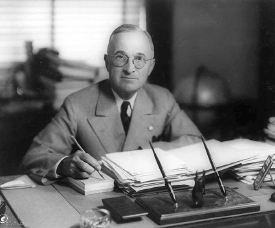
|
|||||||||||||||||||||||||||||||||||||||||||||||||||||
|
Harry Truman probably would have liked Twitter Harry Truman: "I never did give them hell. I just told the truth, and they thought it was hell." 80 characters, including punctuation. It occurs to me this morning this is one of the most American ideas out there. "If you can't stand the heat, get out of the kitchen," another Trumanism. 52 characters.
At dinner last night in a discussion about the future of the University of California Journalism School, I figured something out. Journalism has always been about the sources, but somehow we lost our way and focused on the reporters, the conduits, the pipes. Okay, so the way we move news from sources to their destinations is changing, but when it's all done, the news process yields the same result. So this explains why a 140-character limit in Twitter is so in tune with our times. It teaches us how to summarize, to condense, and it rewards those of us who are good at it by making our ideas go further. It also levels the playing field. Last night there was a 5.0 earthquake in southern California. Not a big one, but Twitter had the full story within a minute. Was there more to say, for cameras and analysts to pore over? Not this time. 140-characters was plenty. Update: The buck stops here. 20 characters, including punctuation. 12/28/05: "One way to do something, no matter how flawed that way is, is better than two, no matter how much better the second way is."
I'm not going to add another format when one exists that differs from mine only by the choice of a name (they call it an image_src, I called it a thumbnail). Their format doesn't call for a type, or height and width -- I'm going to include that info and hope that Digg ignores it. You can see an example by viewing source on this page. To test, I've submitted the example to Digg. They ask if it's an news article, video or image, I chose image. A few steps later and it's submitted, and apparently they picked up the thumbnail. Looks good! Seems like a done deal! Update: FriendFeed does support this format in their bookmarklet. I tested it, and it works. Happy! That's already a lot of compatibility for less than an hour's worth of work. My photo site plugs into Digg and FriendFeed. Bootstrapping thumbnails, revisited Update: After posting this, I learned of a Digg-authored format that does the same thing, and I've adopted it. I'm leaving the rest of this here to form a record, but the format it describes is not implemented.
My first impulse was to create a <link> variant, but to do so would have meant adding width and height attributes. I could have omitted them, but that's ridiculous -- all image processing apps have that information at-hand, and if you don't put it in the HTML, then the client has to do an HTTP reference to get the data, and that's a waste of bandwidth. Better to put the info in one place rather than have N clients fetch it for themselves. However, Zach Beane objected that you can't just invent elements for <link>, so I took a different route and defined an XML namespace for a new thumbnail element. Later, Sam Ruby suggested that HTML allows for arbitrary attributes to be added where they make sense as long as their names begin with "data-". I didn't know about this. So I'm going back to the initial simpler approach and use a <link> element. So here's the new template... <link rel="thumbnail" type="image/jpeg" href="http://static.flickrfan.org/afp/thumbnails/2008/12/28/trpar2329681.jpg" data-width="150" data-height="87"> You can see an example by viewing source on this page. Update: Over on FriendFeed, Paul Buchheit, one of FF's founders, says that Digg has a format that does most of what I'm doing here. There are some weird things about it, like why specify the title in a <meta> element when HTML already has a <title> but I think I have to go with the Digg format. The philosophy: "One way to do something, no matter how flawed that way is, is better than two, no matter how much better the second way is." It's a corollary to Postel's Law, being conservative in what you send. I asked Paul if FF is supporting the Digg proposal. A better choice for Surgeon General Our future President (11 days!) is said to be considering a famous TV doctor for Sur-Gen. Paul Krugman explains why he's not a good choice, and I concur, but something has been bothering me about this, and an email from a friend helped nail it. If you really want to turn things upside-down for the better, instead of a healthy young doctor, how about an older person who is not a doctor, who has health problems and has been treated by the system, someone who has actual experience being a user of American health care. Then let the doctors and insurance companies and HMOs listen a bit. There's no doubt the other users would hear what this person says. (There's a scene in the latest Clint Eastwood film that illustrates this principle beautifully.) I am not suggesting an average or ordinary person, not a Joe The Patient, not a knucklehead or idiot, rather someone with a life of accomplishment, a passion for living, but someone who hasn't lived the perfect life and paid a price, and maybe someone like the future President who saw a relative die sooner or suffer more because of deficiency in the system. That would signal a very pragmatic change -- from health care defining an ideal most of us won't achieve, to improving or just sustaining the reality we make the best of. Thanks to Ann Greenberg, a longtime friend and Berkeley neighbor, for the perspective-shifting email. |
"The protoblogger." - NY Times.
"The father of modern-day content distribution." - PC World.
One of BusinessWeek's 25 Most Influential People on the Web. "Helped popularize blogging, podcasting and RSS." - Time.
"The father of blogging and RSS." - BBC.
"RSS was born in 1997 out of the confluence of Dave Winer's 'Really Simple Syndication' technology, used to push out blog updates, and Netscape's 'Rich Site Summary', which allowed users to create custom Netscape home pages with regularly updated data flows." - Tim O'Reilly.
My most recent trivia on Twitter. On This Day In: 2008 2007 2006 2005 2004 2003 2002 2001 2000 1999 1998. |
||||||||||||||||||||||||||||||||||||||||||||||||||||
|
© Copyright 1997-2009 Dave Winer. Previous / Next |
|||||||||||||||||||||||||||||||||||||||||||||||||||||

 Earlier today I
Earlier today I 


